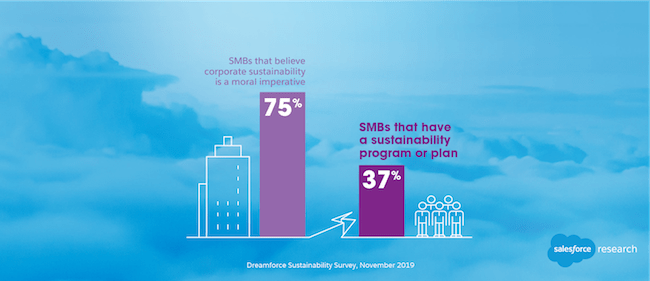
Sustainability is always on our minds here at Salesforce — but what about the rest of our community? Recently Salesforce Research surveyed 1,300+ Dreamforce attendees to find out.
We learned that employees of small and medium businesses (SMBs) feel strongly about their employers’ sustainability practices: 75% of respondents from companies with 250 or less employees say corporate sustainability is a moral imperative.* On the flip side, SMBs are far less likely than larger companies to have an actual sustainability program or strategy: While 69% of respondents at companies with over 1,000 employees said their company had a sustainability program or plan, only 37% at companies with 250 or less employees said the same.* That’s a major gap!

You don’t have to be a large enterprise to practice sustainability. SMBs can certainly make a difference when it comes to helping the planet (99.9% of U.S. businesses are small businesses, after all) and it starts with creating a sustainability plan to guide your operations. Whether you’re a leader looking to improve your earth-friendly efforts or an employee looking to motivate your team, here are five steps to help you create a sustainability plan for your SMB.
Step 1: Identify a sustainability leader
Earth-friendly initiatives are often left to employees to organize. Give yours a fighting chance by recognizing a sustainability leader or green captain who’ll spearhead the efforts. This is a tactical role, a point person who will handle the day-to-day responsibilities, build the strategy, and track the results. As your company grows, you can supplement your green captain with a whole green team. After all, more people means more impact.
Step 2: Secure an executive sponsor
It’s wise to gather your squad before you kick off. That includes finding an executive sponsor who can make sure your efforts are aligned with company priorities, garner support from other executives, and offer ongoing direction as needed. While your green captain focuses on ideas and execution, the executive sponsor is much more strategic in nature. Their influence will help you secure the people, time, and budget necessary to build a successful program.
Step 3: Look at your current reality
As with any goal, it’s necessary to determine your baseline so you can figure out where you want to be. Measure everything you can. How much energy is your company consuming now? Is it coming from renewable sources? How many disposable cups does your office go through in a month? How big is your carbon footprint? The more areas you can measure and details you can add, the easier it will be to demonstrate the need for a formal program and identify opportunities for improvement.
Step 4: Create a vision and set your goals
Once you understand where your company is now, you can start designing a path forward. That means it’s time to define your mission, outline your vision, and set goals.
- What do you hope to achieve with a sustainability program?
- How can your company or product be used for sustainable development?
- What key metrics can you measure and improve upon?
- What will success look like?
Step 5: Strategize and take action
Goals and mission in hand, now’s the time to strategize on how you can use company resources more efficiently and brainstorm initiatives to help you achieve your goals. As you go, consider potential impact, costs, and degree of difficulty. Assign a leader to each initiative you plan; this increases accountability and helps keep the initiative on track. Be sure to define metrics for success and set a finite time period to assess your progress.
No effort is too small
Every sustainability journey has to start somewhere; let yours be here. Begin with a few simple things, and then move on to the more complex. You may not think your SMB can have an impact when it comes to climate change, but even tiny changes can make a huge difference.
* Dreamforce Sustainability Survey, Salesforce Research, November 2019. Note: This survey looked beyond environmental sustainability to include climate and environment, education, workforce and economic development, human health and well-being, gender equality, and civil and institutional partnerships.
Salesforce Essentials helps you find more customers, win their business, and keep them happy so you can grow faster than ever. Learn more about our small business CRM solutions by following us on Twitter, LinkedIn, and Instagram.
Republished by permission. Original here.
Photo via Salesforce
This article, "How to Develop a Sustainability Plan for Your SMB" was first published on Small Business Trends
Originally posted on How to Develop a Sustainability Plan for Your SMB via Small Business and Franchises
No comments:
Post a Comment